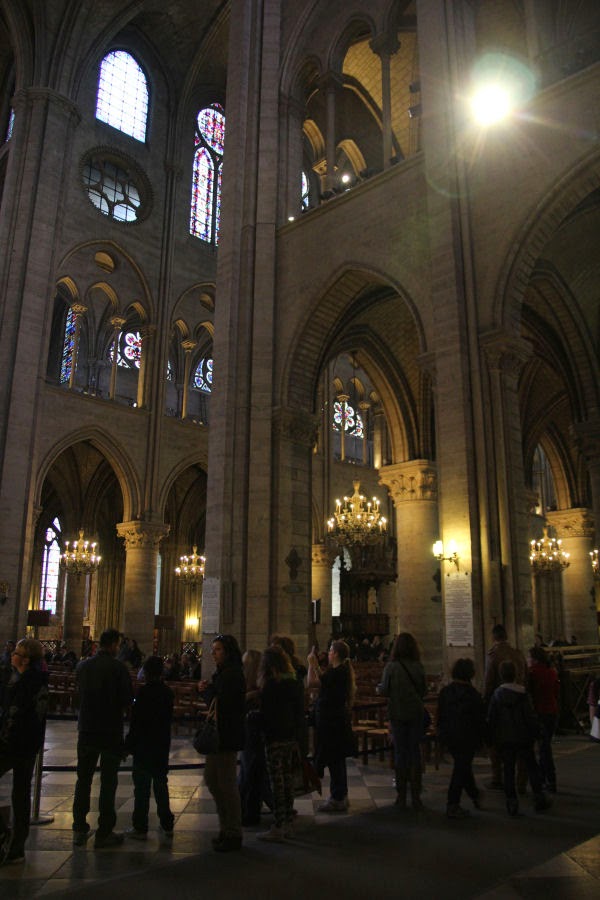This morning we started at the catacombs of Paris. The area in southern Paris was originally quarried as early as the first century for limestone, used to build Lutecia. By the 13th century tunnels were cut into the limestone, which was used to build Notre Dame Cathedral. The resulting empty space was later used to house the remains of over six million Parisians. The total network of tunnels is about 200 miles, but visitors get to traverse only about a mile.
Between the 1700s and 1800s all of the graveyards in Paris were closed due to concerns over sanitation. There were so many bodies overcrowding cemeteries and church yards that the bones were starting to break through the walls of earthen cellars of nearby buildings! The solution was that the remains were all dug up and placed into the catacombs. At first the bones were dumped rather unceremoniously, then they were stacked neatly and into patterns. They are organized by which cemetery they originated from, though some bodies were taken directly to the catacombs during or after the Revolution. There are many markers and memorials.
We climbed down, down, down, into the dark tunnels. There is occasional lighting, but a flashlight helps. There was a black line on the ceiling from the days when visitors had only flashlights or lanterns and needed to orient themselves. I'm very glad to live in a modern age! The ground was damp and slippery in parts, and Maury accidentally bumped someone's skull while nearly falling down (she did say "pardon").
After, we took the metro back to the city center and crossed the Tuileries gardens to the Orangerie museum, where some of Monet's famous Water Lilies murals are housed the way they were intended: Eight huge canvases displayed across two oval-shaped rooms. We were kind of blown away. The variety of light and color usage was beautiful. If this trip had been a little later in the season we would have been able to see Monet's gardens and house at Giverny but in March it is still closed from the winter season. I would have to say that the Orangerie was more than an acceptable alternative!
Since we were so close to the Louvre, we went in through the Carousel entrance, had lunch at the American restaurant with golden arches at the food court, and browsed part of the museum for a few hours. It was nice that visitors were allowed to take pictures, but in a way I kind of wished that it was banned (see pictures below to see what I mean). Still, we covered some of the more famous pieces like the Venus de Milo, Mona Lisa, and Liberty Leading the People.
Maury and I were actually kind of tired after, so we went back to the hotel and had a nice rest before the final farewell dinner with everyone at a restaurant. It was nice to say goodbye to everyone and take pictures with fellow travelers. I was asked to give out the web address to my blog a couple of times so I hope that I accurately re-capped the whole trip!
After dinner Maury and I took one more stroll along the Seine to see the Eiffel Tour at night. Tres bon!
Au revoir! Time to go home tomorrow.
-Dani
After, we took the metro back to the city center and crossed the Tuileries gardens to the Orangerie museum, where some of Monet's famous Water Lilies murals are housed the way they were intended: Eight huge canvases displayed across two oval-shaped rooms. We were kind of blown away. The variety of light and color usage was beautiful. If this trip had been a little later in the season we would have been able to see Monet's gardens and house at Giverny but in March it is still closed from the winter season. I would have to say that the Orangerie was more than an acceptable alternative!
Since we were so close to the Louvre, we went in through the Carousel entrance, had lunch at the American restaurant with golden arches at the food court, and browsed part of the museum for a few hours. It was nice that visitors were allowed to take pictures, but in a way I kind of wished that it was banned (see pictures below to see what I mean). Still, we covered some of the more famous pieces like the Venus de Milo, Mona Lisa, and Liberty Leading the People.
Maury and I were actually kind of tired after, so we went back to the hotel and had a nice rest before the final farewell dinner with everyone at a restaurant. It was nice to say goodbye to everyone and take pictures with fellow travelers. I was asked to give out the web address to my blog a couple of times so I hope that I accurately re-capped the whole trip!
After dinner Maury and I took one more stroll along the Seine to see the Eiffel Tour at night. Tres bon!
Warning: not for people of "a nervous disposition"
The Orangerie
Approaching the Louvre, Venus de Milo inside
Sometimes you forgot you were inside a palace
On the right, Michelangelo's Tortured Slave
Mona Lisa's paparazzi
Most people would push their way to the front of the line and snap a
"selfie" with the painting rather than actually look at it
This bridge was very close the the hotel
and I recognised it from the movie Inception
The "little sister"
Au revoir! Time to go home tomorrow.
-Dani

































































